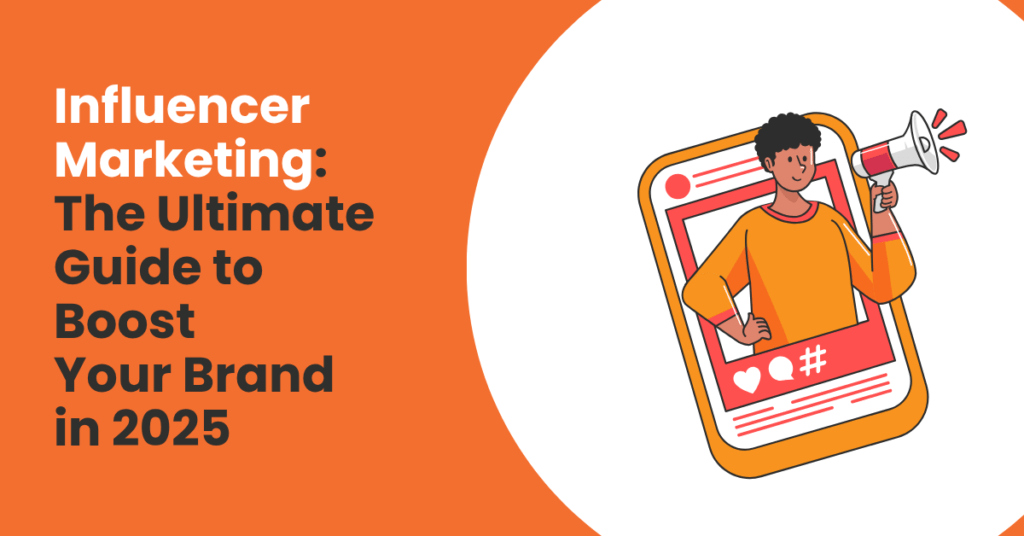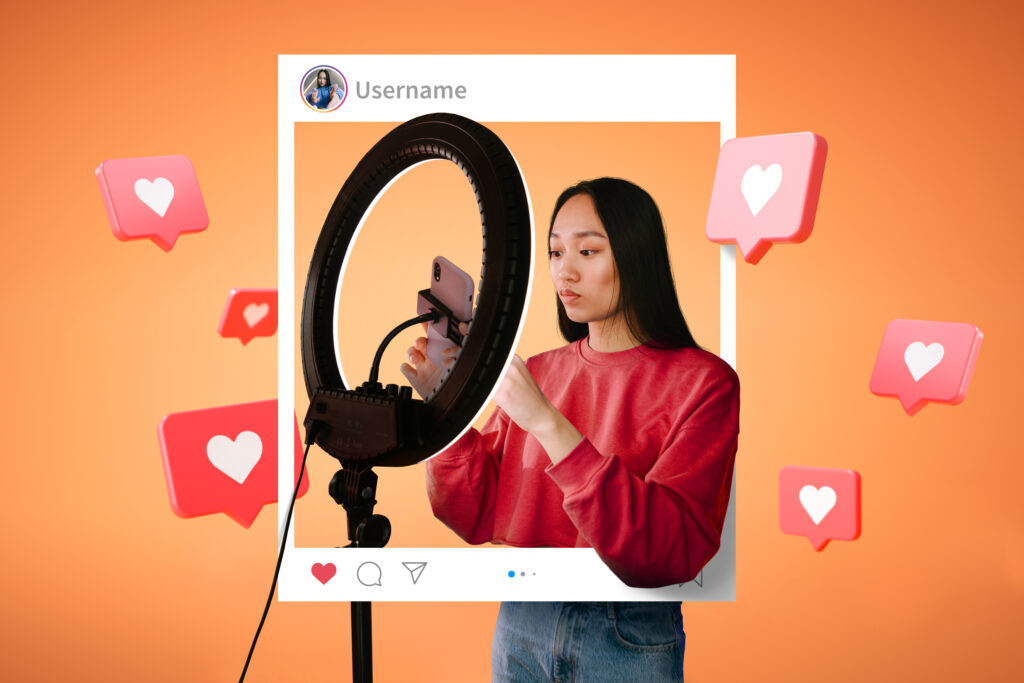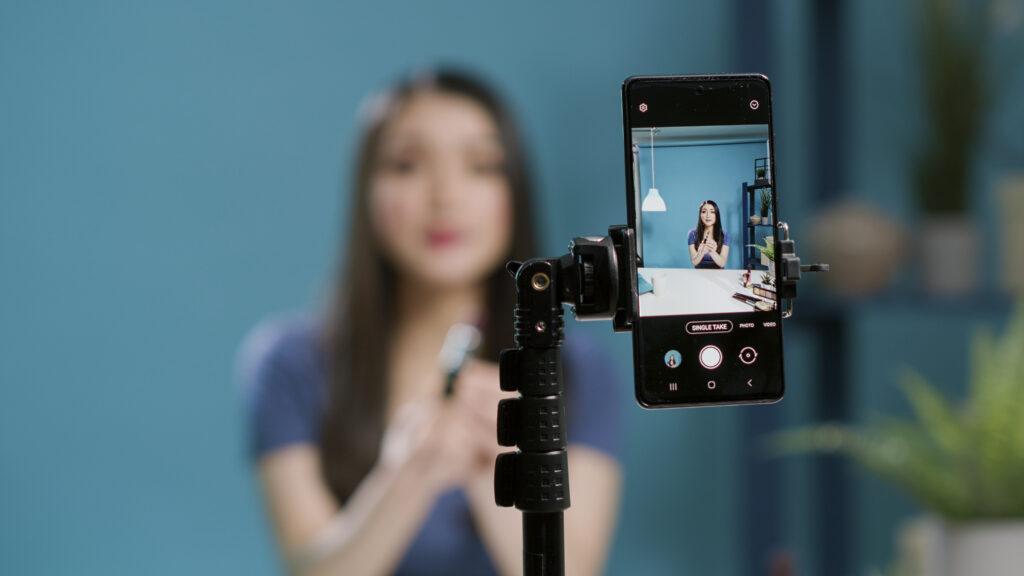Influencer Marketing:
Guide to Boost Your Brand in 2025

The landscape of consumer trust has fundamentally shifted. Audiences no longer find traditional advertising as convincing as they once did. The era of being captivated by polished TV commercials and eye-catching billboards is rapidly disappearing, like influencer marketing.
We’ve entered a new landscape where people automatically skip ads, install ad blockers, and scroll past branded content without a second glance. Even this influncer marketing has its own global forum such as Influencer Marketing Conference.
The average person encounters thousands of advertisements daily, leading to what experts call “ad fatigue”—a phenomenon where audiences have grown so numb to marketing messages that they’ve mastered the art of tuning them out almost completely.
Instead, today’s shoppers put their faith in recommendations from people they look up to and engage with online—influencers. These digital content creators appear in social media feeds every day, offering authentic experiences, candid opinions, and relatable moments.
Whether it’s a beauty guru walking through a new makeup routine, a fitness coach documenting their workout progression, or a tech enthusiast revealing the latest gadgets, these personalities have cultivated communities rooted in trust, consistency, and real connection.
When they suggest a product, it doesn’t come across as an advertisement—it feels more like guidance from a trusted companion.
This dramatic transformation in consumer behavior is precisely why influencer marketing has risen to become one of the most potent strategies for brands aiming to establish genuine trust, broaden their reach to untapped audiences, and generate meaningful conversions that directly affect their bottom line.
In fact, the influencer marketing sector is expected to exceed $24 billion in value by 2025, highlighting just how essential this approach has become for companies of every scale—from ambitious startups to Fortune 500 corporations.
So what exactly is influencer marketing, and how can your brand harness it effectively to remain competitive in this saturated digital marketplace?
Whether you’re taking your first steps or seeking to enhance your current tactics, this in-depth guide will take you through everything necessary to develop successful influencer collaborations that produce tangible results. Let’s explore the dynamic world of influencer marketing.
Also read: 10 Tips for Effective Digital Marketing

What Is Influencer Marketing?
Influencer marketing represents a partnership strategy where brands team up with individuals who have developed robust, engaged online followings—commonly known as influencers—to authentically showcase their products or services. These digital creators span various categories based on their reach and impact:
Mega-influencers (celebrities with millions of followers)
Think household names—professional athletes, Hollywood actors, chart-topping musicians, or major internet personalities. They deliver massive visibility but typically come with hefty price tags and may experience lower engagement rates due to their broad, diverse audiences.
Macro-influencers (100K–1M followers, niche leaders)
These creators have positioned themselves as authorities within particular industries or niches. For instance, a fashion blogger boasting 500K followers or a tech reviewer commanding 300K subscribers. They strike an ideal balance between substantial visibility and specialized audience targeting.
Micro-influencers (10K–100K followers, high engagement rates)
Often viewed as the sweet spot for numerous brands, micro-influencers nurture highly engaged communities. They could be local fitness coaches, beauty enthusiasts, or food bloggers who have cultivated loyal followings through consistent, quality content.
Nano-influencers (under 10K followers, trusted in small communities)
Despite their more modest followings, nano-influencers frequently demonstrate the highest engagement rates and most robust community trust. They’re usually everyday people who are passionate about particular topics—a neighborhood mom blogger, a college student dedicated to sustainable fashion, or a local coffee enthusiast.
Unlike traditional advertising that comes across as corporate and salesy, influencer marketing feels more organic and personal because recommendations originate from a trusted voice rather than directly from the brand itself.
It’s essentially the digital version of word-of-mouth marketing—which has consistently proven to be the most effective form of advertising.
Also read: 10 Free SEO Tools to Improve Your Digital Marketing Faster

Why Influencer Marketing Works
The main job of influencer is making contents. To measure the content is good or bad, we can see whether those content become viral. When a lot of people see the content, it would be a WIN for marketing.
Trust & Authenticity
During this age of ad fatigue and banner blindness, people place far more trust in recommendations from real individuals than traditional advertisements.
In fact, comprehensive studies reveal that roughly 90% of consumers assign significant value to recommendations from individuals they follow online. When an influencer they respect uses and endorses a product, it carries the weight of a personal suggestion from a friend—not an interruption from a corporation attempting to sell them something.
Targeted Reach
Influencers have already completed the hard work of assembling audiences that align seamlessly with specific niches, interests, and demographics.
Rather than investing premium prices for mass advertising that reaches thousands of disinterested viewers, you can precisely target people who are already inclined to care about what you’re offering.
For instance, if you sell eco-friendly yoga mats, collaborating with a sustainability-focused wellness influencer ensures your product appears before people already interested in both yoga and environmental consciousness.
Engagement & Storytelling
Influencers are content creation specialists who develop engaging, relatable narratives that genuinely resonate with their followers.
They understand how to integrate your brand into stories, tutorials, daily routines, and authentic experiences—transforming your brand into part of an ongoing conversation rather than just another disruptive advertisement.
When a beauty influencer incorporates your skincare product into their morning routine, or a travel influencer features your luggage during their actual journey, it establishes context and connection that traditional ads simply cannot replicate.
Cost-Effective Growth
When compared to traditional advertising channels like television commercials, print ads, or even certain digital advertising methods, influencer partnerships—particularly with micro or nano-influencers—frequently deliver substantially higher return on investment (ROI) with considerably lower expenses.
A single Instagram post from a micro-influencer might run a few hundred dollars but reach thousands of highly targeted, engaged potential customers, whereas a traditional ad campaign could cost thousands with less guaranteed engagement or conversion.
Also read: 5 Digital Marketing Strategy For Your Startup To Start Now

How to Build a Successful Influencer Marketing Strategy
1. Define Your Goals
Before reaching out to any influencers, clearly establish what you’re attempting to accomplish. Consider whether you want to:
- Amplify brand awareness and introduce to fresh audiences
- Generate direct sales or registrations for your product or service
- Expand your social media presence and follower base
- Establish credibility and trust within your niche or industry
- Launch a new product with significant buzz and excitement
- Enhance your brand’s reputation or transform your image
Clear, measurable objectives will dictate your entire strategy—from which influencers you collaborate with to how you gauge success. For example, if your objective is brand awareness, you’ll prioritize influencers with extensive reach, but if you’re focused on conversions, engagement rate and audience trust become more critical metrics.
2. Identify the Right Influencers
This is where numerous brands make critical mistakes. Look beyond follower count—vanity metrics can be misleading. Instead, concentrate on these essential factors:
- Relevance: Do they align with your brand values, aesthetic, and target audience? A luxury watch brand wouldn’t gain from collaborating with a budget lifestyle blogger, regardless of their follower count.
- Engagement: Do their followers actively comment, like, share, and interact with their content? An influencer with 50K followers and 5% engagement holds far more value than one with 500K followers and 0.5% engagement.
- Authenticity: Do they genuinely connect with their audience, or do their posts seem forced and overly promotional? Examine their comment sections—are people having real conversations, or are comments generic and bot-like?
Example: A fitness brand will achieve dramatically superior results from collaborating with a certified personal trainer who shares workout tutorials on Instagram than with a celebrity chef who possesses more followers but an audience interested primarily in cooking, not fitness equipment.
3. Choose the Right Platform
Different social media platforms serve distinct purposes and attract varied demographics and content styles:
- Instagram & TikTok: Optimal for lifestyle, beauty, fashion, food, fitness, travel, and visually-driven content. These platforms excel at short-form video content, carousel posts, and stories that stimulate immediate engagement.
- YouTube: Perfect for long-form tutorials, comprehensive product reviews, unboxing experiences, and in-depth demonstrations where influencers can thoroughly showcase your product’s features and benefits.
- LinkedIn: The preferred platform for B2B influencer partnerships, thought leadership content, professional services, and connecting with decision-makers in corporate environments.
- X (Twitter): Ideal for thought leadership, participating in trending conversations, real-time marketing, and reaching audiences interested in news, technology, and current events.
- Pinterest: Often overlooked but exceptional for DIY, home décor, fashion, recipes, and products with strong visual appeal that benefit from evergreen, searchable content.
Also read: The Psychology Behind High-Converting Landing Pages

4. Collaborate Creatively
The days of simply requesting influencers to “post a product photo with our hashtag” are long gone. Modern audiences can detect inauthentic sponsored content instantly. Instead, explore creative collaboration formats:
- Product reviews or tutorials: Allow influencers to demonstrate how your product solves a real problem or fits seamlessly into their daily routine
- Behind-the-scenes content: Reveal the human side of your brand through factory tours, team introductions, or product development journeys
- Giveaways or contests: Stimulate engagement and follower growth while putting your product directly in potential customers’ hands
- Unboxing videos: Capitalize on the excitement and anticipation of experiencing your product for the first time
- Story takeovers: Permit influencers to temporarily manage your brand’s social media stories for an authentic, fresh perspective
- Challenge campaigns: Develop branded challenges or trends that encourage widespread user participation (similar to viral TikTok challenges)
- Affiliate or discount codes: Provide influencers personalized codes that benefit both their audience and allow you to track conversions effectively
Creative, authentic campaigns generate more genuine engagement because they resemble natural content rather than forced advertisements.
5. Measure & Analyze
What gets measured gets managed. Track your ROI and campaign effectiveness with these critical metrics:
- Reach & impressions: How many people viewed the content?
- Engagement rate: What percentage of viewers liked, commented, shared, or saved the content?
- Website traffic from influencer links: Are people clicking through to discover more about your offerings?
- Conversions & sales: Are viewers transforming into paying customers?
- Brand sentiment: How are people discussing your brand in comments and online discussions?
- Follower growth: Did your social media accounts acquire new followers during the campaign period?
- Cost per acquisition (CPA): How much did you invest to acquire each new customer through the campaign?
Utilize tools like Google Analytics, UTM tracking links, affiliate platforms, or specialized influencer marketing platforms like AspireIQ, Upfluence, or CreatorIQ to measure campaign effectiveness accurately and make data-driven decisions for future partnerships.
Also read: The Secret to Turning Organic Traffic into Quality Leads

Influencer Marketing Trends in 2025
Rise of Nano & Micro-Influencers
Small creators with highly niche, engaged audiences continue to yield higher engagement rates and superior ROI compared to mega-influencers for most brands.
Their recommendations come across as more personal and trustworthy, and they’re more budget-friendly for brands with limited marketing resources.
We’re witnessing major brands redirect budgets away from single celebrity partnerships toward collaborating with dozens of micro-influencers simultaneously.
Authenticity Over Perfection
Modern audiences, particularly Gen Z and younger millennials, increasingly favor raw, relatable, unfiltered content over the polished, perfectly staged campaigns of the past.
Influencers who display real life—including flaws, failures, and candid opinions—are forging stronger connections with their communities. User-generated content (UGC) style posts often outperform highly produced content in terms of engagement and conversion.
AI-Powered Matching
More brands are harnessing artificial intelligence and machine learning tools to discover influencers whose audiences align perfectly with their ideal customer profiles.
These advanced platforms examine audience demographics, interests, engagement patterns, and even sentiment analysis to predict campaign success before investing a single dollar. This data-driven approach minimizes risk and maximizes ROI significantly.
Video Dominance
Short-form video content on TikTok, Instagram Reels, YouTube Shorts, and similar platforms represents the future of influencer content creation.
These formats stimulate the highest engagement rates, benefit from powerful algorithms that promote viral content, and resonate strongly with younger audiences who increasingly favor video over static images or text-based content.
Long-Term Partnerships
The most successful brands are transitioning away from one-off transactional campaigns toward cultivating long-term brand ambassador programs.
These ongoing relationships foster deeper trust with audiences (who observe consistent, repeated endorsements over time), provide superior value for brands (with lower costs per post), and allow influencers to genuinely integrate products into their lifestyles rather than treating them as temporary sponsors.
When an influencer uses and promotes your product consistently over months or years, their endorsement carries exponentially more credibility and weight.
Also read: 4 Impactful Tips to Kickstart your Digital Marketing Career

Final Thoughts: Why Authenticity Wins in Influencer Marketing
Influencer marketing isn’t merely a passing trend or optional tactic—it’s a fundamental strategy for brands that want to grow, compete, and thrive in today’s digital economy.
By strategically collaborating with the right influencers, developing authentic and creative campaigns, and consistently measuring results to optimize performance, businesses of all sizes can establish trust, foster loyalty, and achieve sustainable long-term growth.
The beauty of influencer marketing lies in its versatility and scalability. Whether you’re a small business with a modest budget working with local nano-influencers, or a multinational corporation running campaigns with multiple macro-influencers across different regions, the principles remain the same. Start small, test different approaches, and scale what works.
Don’t be afraid to experiment with various content formats, platforms, and influencer tiers until you find the perfect fit for your brand.
Remember that building successful influencer relationships takes time and effort. The most impactful partnerships aren’t transactional—they’re collaborative.
Treat influencers as creative partners rather than advertising channels. Give them creative freedom to present your products in ways that feel natural to their content style and authentic to their audience.
When influencers feel respected and valued, they become genuine advocates for your brand, and that authenticity shines through in every post, story, and video they create.
The key to success is authenticity above all else. When influencer marketing feels real, genuine, and aligned with an influencer’s true voice and values, it resonates deeply with audiences—and that’s precisely when brands witness meaningful, measurable results that impact their bottom line and cultivate lasting customer relationships.
In 2025 and beyond, the brands that prioritize authentic storytelling and genuine connections over polished perfection will be the ones that truly stand out and win the hearts of consumers.


